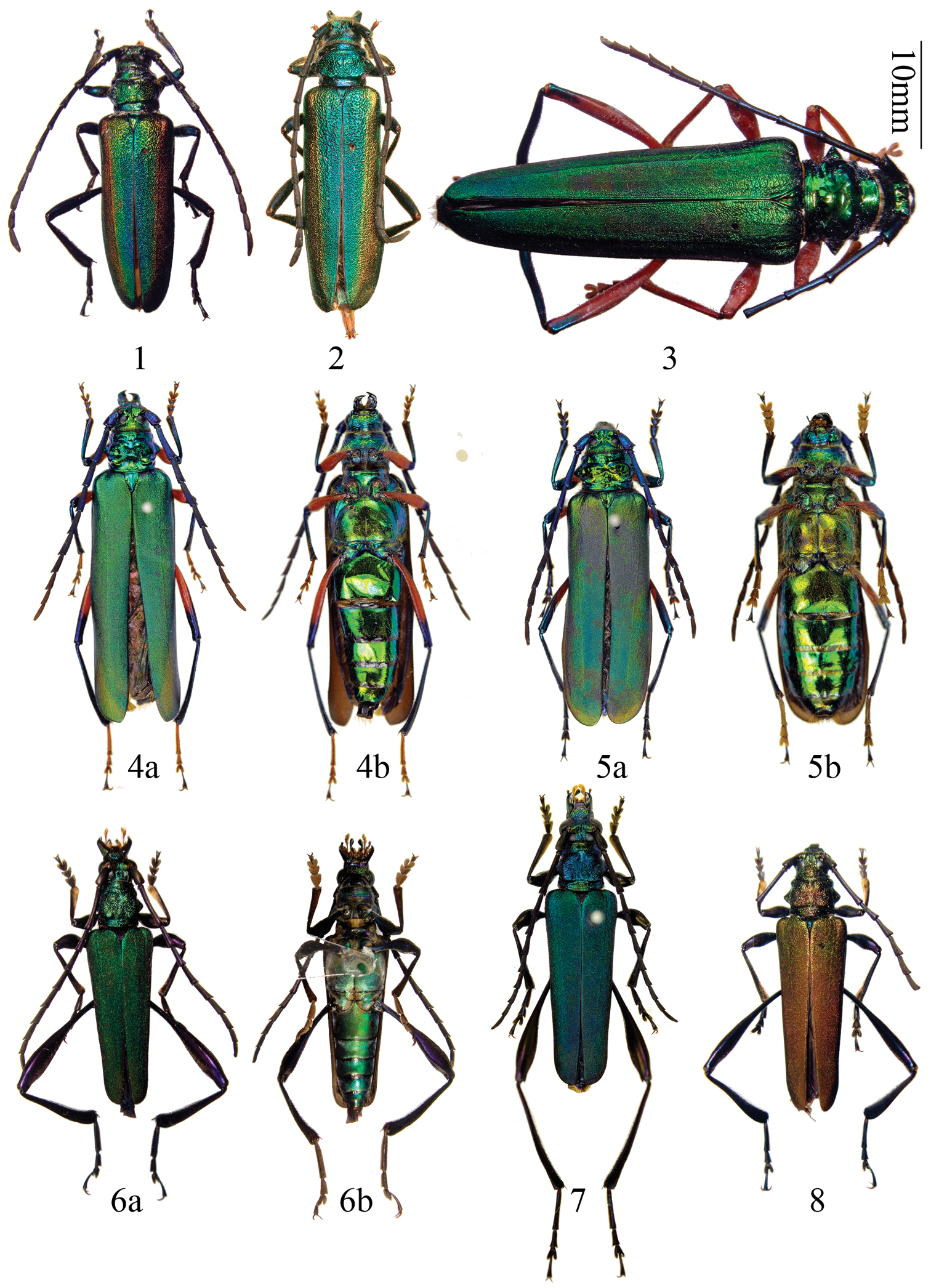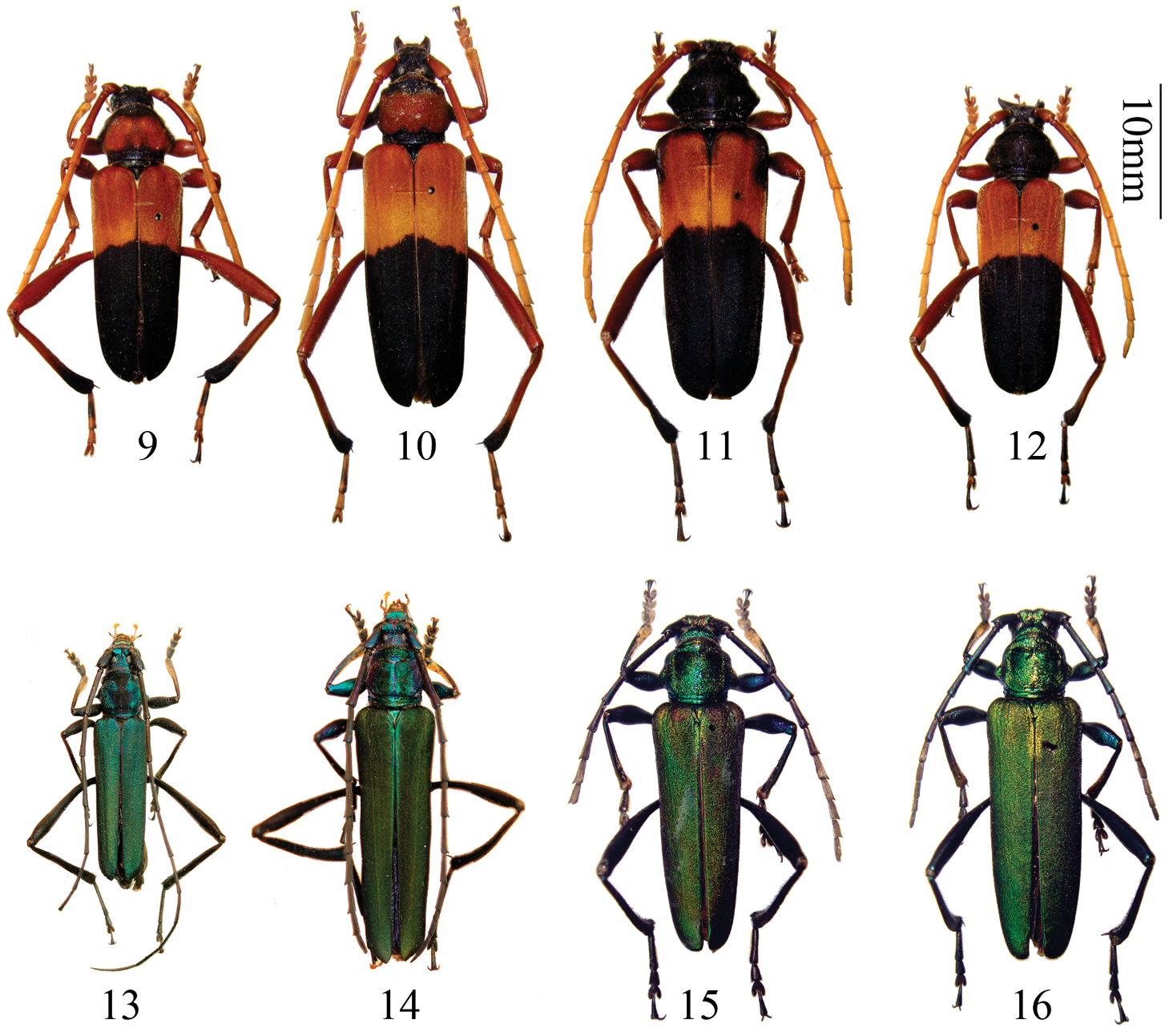






(C) 2013 Eduard Vives. This is an open access article distributed under the terms of the Creative Commons Attribution License 3.0 (CC-BY), which permits unrestricted use, distribution, and reproduction in any medium, provided the original author and source are credited.
For reference, use of the paginated PDF or printed version of this article is recommended.
One new species, Schwarzerium yunnanum sp. n. is described from Yunnan Province, China. And a new subgenus Rugosochroma subgen. n. is erected for it. Additionally, Seven species of the tribe Callichromatini are newly recorded from China: Aphrodisium niisatoi Vives & Bentanachs, 2007, Aphrodisium tricoloripes Pic, 1925, Chelidonium violaceimembris Gressitt & Rondon, 1970 (new from Vietnam too), Chloridolum grossepunctatum Gressitt & Rondon, 1970 (new from Vietnam too), Chloridolum semipunctatum Gressit & Rondon 1970, Embrikstrandia vivesi Bentanachs, 2005 and Laosaphrodisium subplicatum (Pic, 1937).
Callichromatini, new subgenus, new species, new records, China, Oriental region
The recent visit of the first author to the IZAS Collection (Institute of Zoology, Chinese Academy of Sciences, Beijing), enabled the identification of many Callichromatini species along with interesting observations, some of them described in this work. The Callichromatini material in IZAS was not well studied before this work, with many specimens only identified at generic level. Seven species were found to be new for the Chinese fauna and herein reported for the first time. Meanwhile, one new subgenus and species are described from Yunnan.
BPBM Bernice P. Bishop Museum, Honolulu, USA
CCCC Collection of Chang-chin Chen, Tianjin, China
CJBB Collection of Joan Bentanachs, Barcelona, Spain
EVC Eduard Vives collection, Terrassa, Spain
IZAS Institute of Zoology, Chinese Academy of Sciences, Beijing, China
MNHN Muséum National d’Histoire Naturelle, Paris, France
Schwarzerium (Rugosochroma) yunnanum sp. n.
See “Diagnosis” below.
Rugoso+chroma in reference of this new subgenus have wrinkled all the pronotal and elytral surface. Rugoso meaning wrinkled in Latin and chroma meaning colour in Greek. Masculine gender.
urn:lsid:zoobank.org:act:EEEC8301-4F43-4F39-B9D5-226188FBEABC
http://species-id.net/wiki/Schwarzerium_yunnanum
Figs 1–2Ground integument color bluish green, more intensely bluish and with long silvery pubescence underneath; antennae and legs bluish black; tarsi black, except slightly reddish onychium; head and pronotum shiny golden green; scutellum bluish green; elytra bluish green broadly along suture, with golden green dorsal longitudinal stripe, reaching from base to apex of elytra, cupreous golden sides from humeri to apex, and bluish epipleural margin.
Head large, transverse, strongly punctured, longitudinally furrowed from interantennal space to epistome; epistome short, straight, strongly punctured. Mandibles short, thick, slightly bent apically. Labrum trapezoidal, free, covered by fossulae and abundant golden setae. Eyes microfaceted, weakly protruding; upper lobe much smaller than lower. Antennae long, covered by long black setae and reaching apical 1/5 of elytra in males and apical quarter in females; segments saw-like beyond fifth antennomere, each segment (except first and second) with strong longitudinal outer margin demarcating two longitudinal porous areas.
Pronotum transverse (17:24), with strong transverse anterior depression on disc and two posterior transverse medially prominent humps; anterior border simple, posterior border weakly margined; sides armed with short median smooth bulge and smaller protuberance close to anterior angle; surface of pronotum strongly punctured, with golden setae at sides. Prosternum nearly smooth, shiny, with transverse striation at anterior half; prosternal process broad, punctured, expanded posteriorly to enclose procoxal cavities behind. Mesoventrite short, transverse, strongly punctured, wide between mesocoxae. Metaventrite longitudinally furrowed, finely punctured, covered by dense silvery white pubescence. Abdominal ventrites rather smooth and glossy, weakly punctured, sparsely pubescent; puncturation on pygidium stronger.
Scutellum triangular, margined laterally, smooth, depressed medially. Elytra long, narrow (11:4), sides subparallel; humeri round, protruding; suture fine, unmarginated; apex of elytra broadly round, with slightly marked sutural angle; surface of elytra rough, particularly at basal third, less so at apical quarter, covered by very sparse short, fine silvery tomentum; pubescence in apical area longer, denser and black.
Legs short and slender; profemora enlarged medially, meso- and metafemora widened apically; mesotibiae slightly arched, metatibiae flattened; pro- and mesotarsi short and wide; first metatarsomere laterally compressed, and remaining metatarsomeres short and broad.
Schwarzerium (Rugosochroma) yunnanum subgen. n., sp. n., holotype male, from Yunnan 2 paratype, female, from Yunnan (in EVC) 3 Aphrodisium niisatoi Vives & Bentanachs, 2007, female, from Yunnan 4–5 Aphrodisium tricoloripes Pic, 1925 4 female, from Guizhou 5 female, from Yunnan 6–8 Chelidonium violaceimembris Gressitt & Rondon, 1970 6 male, from Hainan 7 female, from Hainan 8 female, from Yunnan. a. dorsal view. b. ventral view. Scale 10 mm.
This new species is similar to Schwarzerium provosti (Fairmaire) in its golden coloration and rough pronotum, but Schwarzerium yunnanum can be distinguished by the smaller size, elytra more parallel, and very short unicolor legs without club-shaped mesofemora. It differs from every other species in the genus Schwarzerium Plavilstshikov in the second metatarsomere not compressed. Based on the divergence in this character, together with the distinctive shape of mesofemora, we propose to establish a new subgenus, Rugosochroma subgen. n. (noun, masculine), with Schwarzerium yunnanum sp. n. as the subgeneric type.
The species is named after the type locality “Yunnan”.
China: Yunnan.
China, Yunnan Prov.: holotype: male, Yunnan, Zhongdian, Chongjianghe, alt. 1800 m, 1984.VIII.6, leg. Jianguo Fan (IZAS, IOZ(E) 1859281). Paratypes: 1 male (IZAS, IOZ(E) 1859283) and 1 female (EVC, ex IZAS, IOZ(E) 1905092), same data to holotype; 1 female, Yunnan, Lijiang, Yulongshan, alt. 2800 m, 1984.VIII.6, leg. Ruiqi Wang (IZAS, IOZ(E) 1859282).
http://species-id.net/wiki/Aphrodisium_niisatoi
Fig. 3This species is very typical with sexual dimorphism represented by larger mandibles in males than females.
China (new country record): Yunnan; Vietnam.
China, Yunnan Prov.: 1 female, 8 km North of Simao, 1957.V.22, leg. A. Monchadsky (IZAS); 1 male and 1 female, Yunnan, Mt. Kabi-ke, Menglian, 2006.VI.2, leg. local collector (EVC). Vietnam, Vinh Phuc Prov.: holotype, male, Tonkin, Mt. Tam Dao, 2001.VI. leg. Local collector (EVC).
http://species-id.net/wiki/Aphrodisium_tricoloripes
Figs 4–5This is a very rare species only known from China, Myanmar and Vietnam. It is close to Aphordisium cribricolle Poll, 1890, but can be separated by the morphological feature of pronotum and the typical color of the legs.
China (new country record): Guizhou, Yunnan; Myanmar (
China, Guizhou Prov.: 1 female, Guizhou, Tongren, Jiangkou, Fanjingshan, 4500bu, alt. 1775, 2010.V-IX, leg. local collector (CCCC); China, Yunnan Prov.: 1 female, Yunnan, Deqin county, 28°28.835'N, 98°51.140'E–28°26.610'N, 98°55.212'E, alt. 3000–3500 m, 2006.VIII.10, light trap, leg. Xiaodong Yang (CCCC, 06B0683). Holotype, male, Tonkin, Anam. (MNHN, ex Collection M. Pic).
http://species-id.net/wiki/Chelidonium_violaceimembris
Figs 6–8This is a typical oriental species. Very common in Laos and Vietnam and should be common in South China too.
China (new country record): Hainan, Yunnan; Laos, Vietnam (new country record).
China, Yunnan Prov.: 1 female, Yunnan, Xishuangbanna, Menghun, alt. 1200–1400 m, 1968.V.22, leg. Yiran Zhang (IZAS). China, Hainan Prov.: 2 males, Hainan, Baisha county, Yinggeling, alt. 600–780 m, 2011.IV.27–30, leg. Wenhsin Lin (IZAS & CCCC); 1 male, Baisha county, Yinggeling, Yinggezui, 2011.IV.30, leg. Yiting Chung (CCCC); 1 male 1 female, Wuzhishan, Dengshandao (entrance), 18.90840°N, 109.67359°E, alt. 708 m, 2010.IV.10, leg. Kuiyan Zhang (IZAS); 1 female, Hainan, Wuzhishan, 2010.IV.9, leg. WenI Chou (CCCC); 1 male, same data but 2010.IV.7; 1 female, Hainan, Qiongzhong county, Limushanzhufeng, 19.17863°N, 109.75071°E, alt. 840 m, 2010.IV.6, leg. Meiying Lin (IZAS); 3 males, Jianfengling, 2010.IV.13, leg. Wenhsin Lin (CCCC). Vietnam, Vinh Phuc Prov.: 3 males 2 females, Tam Dao National Park, 2011.VI.12 (EVC). Laos, Vientiane Prov.: holotype, male, Phou Khao Khoay, 1040 m, 1965.V.31, leg. J. A. Rondon (BPBM, examined by E. Vives in 2007.).
http://species-id.net/wiki/Embrikstrandia_vivesi
Figs 9–12This species is highly polymorphic in elytral and pronotal coloration. The IZAS collection contains specimens showing the base of elytra completely red, and the series from Yunnan includes specimens with their pronotum black and reddish.
China (new country record): Yunnan; Laos.
China Yunnan Prov.: 5 males 3 females, Yunnan, Jinping, Mengla, alt. 400 m, 1956.IV.28–29, leg. Keren Huang et. al (IZAS); 2 males, same data but 1956.IV.24; 1 male, same data but 1956.V.1; 1 male 1 female, same data but alt. 500 m, 1956.V.2; 1 male, Yunnan, Xishuangbanna, Xiaomengyang, alt. 850 m, 1957.VI.14, leg. Lingchao Zang (IZAS); 5 females, Yunnan, Xishuangbanna, Menghun, alt. 750 m, 1958.VI.2–7, leg. Xuwu Meng et al (IZAS); 1 female, same data but alt. 1200 m, 1958.V.31. Laos, Xieng Khouang Prov.: holotype, male, Laos, Xieng Khouang, 1997.VI (CJBB).
Embrikstrandia vivesi Bentanachs, 2005. 9 male, from Yunnan, pronotum mostly red 10 female, from Yunnan, pronotum mostly red 11 female, from Yunnan, pronotum mostly black 12 male, from Yunnan, pronotum mostly black 13 Chloridolum grossepunctatum Gressitt & Rondon, 1970. male, from Yunnan 14 Chloridolum semipunctatum Gressit & Rondon 1970. male, from Yunnan 15–16 Laosaphrodisium subplicatum (Pic, 1937) 15 male, from Guizhou 16 female, from Guizhou. Scale 10 mm.
http://species-id.net/wiki/Chloridolum_grossepunctatum
Fig. 13This is a small species described from Laos and it is very common in North Vietnam.
China (new country record): Yunnan; Laos; Vietnam (new country record).
China, Yunnan Prov.: 2 males, Yunnan, Mt. Daningshan, 2012.VI.7, leg. local collector (EVC). Vietnam, Vinh Phuc Prov.: 2 males 3 females, N. Vietnam, Tam Dao National Park, 2011.VI.12, leg. E. Vives (EVC). Laos, Vientiane Prov.: holotype, male, Laos, Vientiane Prov., Ban Van Heua, 1035 m, 1965.IV.30 (BPBM, Bishop 8361, examined by E. Vives in 2007.).
http://species-id.net/wiki/Chloridolum_semipunctatum
Fig. 14This is a very rare species in Northern Laos. The morphology of this species is very different of other Chloridolum species.
China (new country record): Yunnan; Laos.
China, Yunnan Prov.: 1 male, Mt. Gaoligongshan, 2012.VI.12, leg. local collector (EVC). Laos, Sayaboury Prov.: holotype, male, Laos, Sayaboury (Xaignabouri), 280 m, 1966.V.20 (BPBM, Bishop 8362, examined by E. Vives in 2007.).
http://species-id.net/wiki/Laosaphrodisium_subplicatum
Figs 15–16This species was originally described as a variety of Chelidonium gibbicolle by
Although
China (new country record): Guizhou; Laos, Vietnam.
China, Guizhou Prov.: 1 female, Guizhou, Shiqian, Jinxing, alt. 670 m, 1988.VII.24, leg. Shuyong Wang (IZAS); 1 female, same data but alt. 670–800 m; 1 male, Guizhou, Shiqian, Jinxing, alt. 800 m, 1988.VII.25, leg. Hongxing Li (IZAS). Vietnam, Vinh Phuc Prov.: 2 males 1 female, Vinh Phuc Prov., Tam Dao National Park, 2011.VI.20, leg. E. Vives (EVC); holotype, male, Vietnam, Tonkin, Hoa-Binh (MNHN, ex Collection M. Pic).
We would like to express our thanks to Thierry Deuve and Olivier Montreuil (MNHN collection-Paris), Chang-chin Chen (CCCC) for giving access to the collections, offering pictures and the loans of specimens. We thank Joan Bentanachs (CJBB) for the discussion on Laosaphrodisium subplicatum and Steven W. Lingafelter (National Museum of Natural History, Washington, USA) for improving this manuscript. This research was supported by the National Natural Science Foundation of China (No. 31000967 & J1210002), and a grant (No. O529YX5105) from the Key Laboratory of the Zoological Systematics and Evolution of the Chinese Academy of Sciences.

